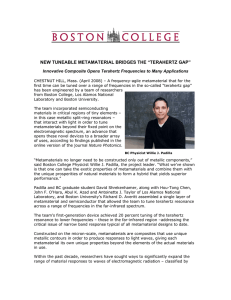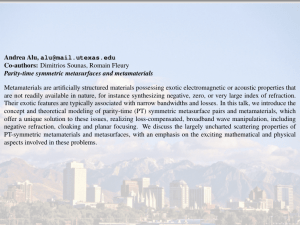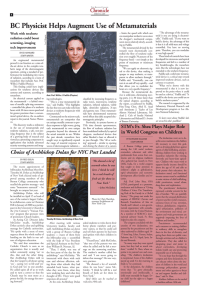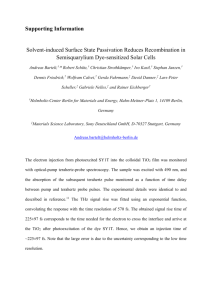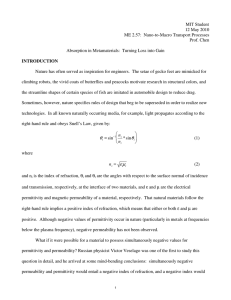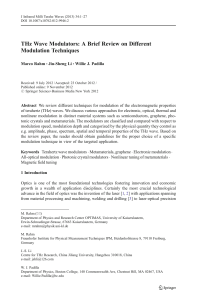Boston College NEW TUNEABLE METAMATERIAL BRIDGES THE “TERAHERTZ GAP”
advertisement
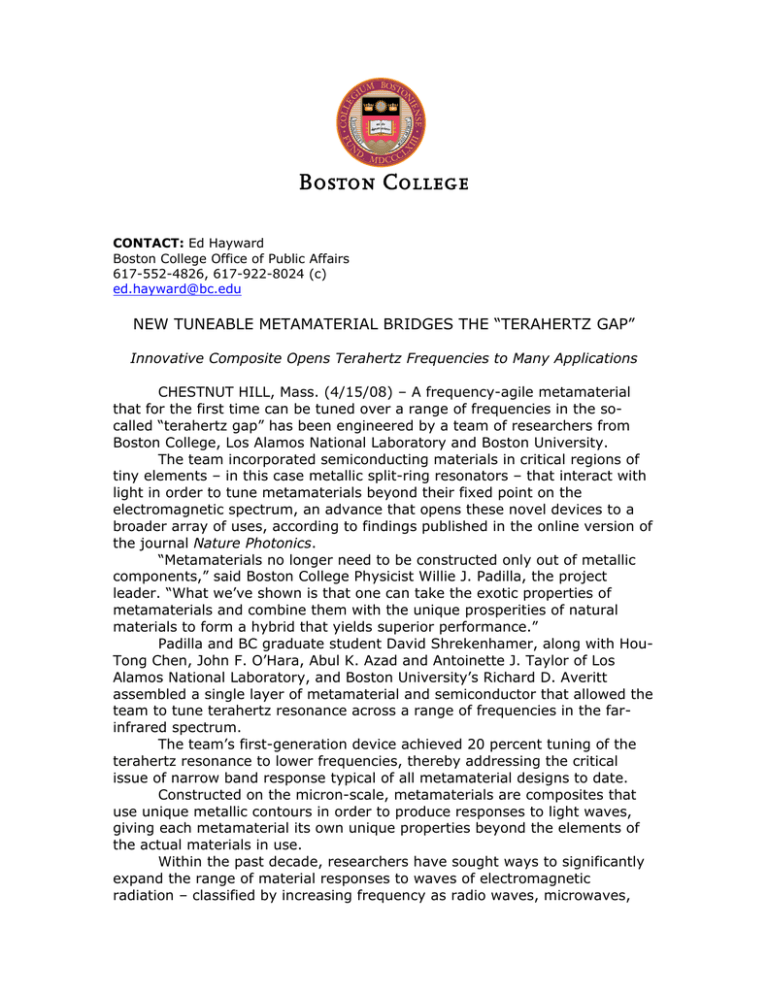
Boston College CONTACT: Ed Hayward Boston College Office of Public Affairs 617-552-4826, 617-922-8024 (c) ed.hayward@bc.edu NEW TUNEABLE METAMATERIAL BRIDGES THE “TERAHERTZ GAP” Innovative Composite Opens Terahertz Frequencies to Many Applications CHESTNUT HILL, Mass. (4/15/08) – A frequency-agile metamaterial that for the first time can be tuned over a range of frequencies in the socalled “terahertz gap” has been engineered by a team of researchers from Boston College, Los Alamos National Laboratory and Boston University. The team incorporated semiconducting materials in critical regions of tiny elements – in this case metallic split-ring resonators – that interact with light in order to tune metamaterials beyond their fixed point on the electromagnetic spectrum, an advance that opens these novel devices to a broader array of uses, according to findings published in the online version of the journal Nature Photonics. “Metamaterials no longer need to be constructed only out of metallic components,” said Boston College Physicist Willie J. Padilla, the project leader. “What we’ve shown is that one can take the exotic properties of metamaterials and combine them with the unique prosperities of natural materials to form a hybrid that yields superior performance.” Padilla and BC graduate student David Shrekenhamer, along with HouTong Chen, John F. O’Hara, Abul K. Azad and Antoinette J. Taylor of Los Alamos National Laboratory, and Boston University’s Richard D. Averitt assembled a single layer of metamaterial and semiconductor that allowed the team to tune terahertz resonance across a range of frequencies in the farinfrared spectrum. The team’s first-generation device achieved 20 percent tuning of the terahertz resonance to lower frequencies, thereby addressing the critical issue of narrow band response typical of all metamaterial designs to date. Constructed on the micron-scale, metamaterials are composites that use unique metallic contours in order to produce responses to light waves, giving each metamaterial its own unique properties beyond the elements of the actual materials in use. Within the past decade, researchers have sought ways to significantly expand the range of material responses to waves of electromagnetic radiation – classified by increasing frequency as radio waves, microwaves, terahertz radiation, infrared radiation, visible light, ultraviolet radiation, Xrays and gamma rays. Numerous novel effects have been demonstrated that defy accepted electromagnetic principles. “Metamaterials demonstrated negative refractive index and up until that point the commonly held belief was that only a positive index was possible,” said Padilla. “Metamaterials gave us access to new regimes of electromagnetic response that you could not get from normal materials.” Prior research has shown that because they rely on light-driven resonance, metamaterials experience frequency dispersion and narrow bandwidth operation where the centre frequency is fixed based on the geometry and dimensions of the elements comprising the metamaterial composite. The team believes that the creation of a material that addresses the narrow bandwidth limitations can advance the use of metamaterials. Enormous efforts have focused on the search for materials that could respond to terahertz radiation; a scientific quest to find the building blocks for devices that could take advantage of the frequency for imaging and other applications. Potential applications could lie in medical imaging or security screening, said Padilla. Materials undetectable through x-ray scans – such as chemicals, biological agents, and certain explosives – can provide a unique “fingerprint” when struck by radiation in the far-infrared spectrum. Metamaterials like the one developed by the research team will facilitate future devices operating at the terahertz frequency of the electromagnetic spectrum. In addition to imaging and screening, researchers and high-tech companies are probing the use of terahertz in switches, modulators, lenses, detectors, high bit-rate communications, secure communications, the detection of chemical and biological agents and characterization of explosives, according to Los Alamos National Laboratory. Links: Nature Photonics: http://www.nature.com/nphoton/journal/vaop/ncurrent/full/nphoton.2008.52 .html To learn more about Professor Padilla’s lab, please see: http://www.physics.bc.edu/Deptsite/people_new/padilla.shtml
